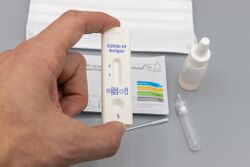Sodium azide
(chemical) | |
|---|---|
 | |
| A highly toxic chemical present in the self-administered antibody COVID test kit "flying off the shelves" by the end of 2021. |
Sodium azide is a highly toxic chemical. It is used in making chemicals, as a preservative in diagnostic medicines and blood tests, as a herbicide, fungicide and soil fumigant, and is the propellant used for inflating automobile air bags. No antidote exists for azide poisoning[1].
A reagent containing sodium azide is in the self-administered antibody COVID test kit "flying off the shelves"[2] by the end of 2021, with a test procedure that is complex enough to allow fumbles and mistakes — such as a spill of the deadly chemical.[3]
The amount of sodium azide used is very small, but the chemical is very potent, and an exposure will easily lead to symptoms that can easily - and maybe on purpose - be confused for what is called "Covid".

Poison
Sodium azide prevents the cells of the body from using oxygen. When this happens, the cells die. Sodium azide is more harmful to the heart and the brain than to other organs, because the heart and the brain use a lot of oxygen.[5]
The most commonly reported health effect from azide exposure is hypotension, almost independent of route of exposure. Most industrial exposures are by inhalation. Most laboratory exposures or suicide attempts are by ingestion. The time between exposure and detection of hypotension can predict outcome.
Fatal doses occur with exposures of >or=700 mg (10 mg/kg). Nonlethal doses ranged from 0.3 to 150 mg (0.004 to 2 mg/kg).
Onset of hypotension within minutes or in less than an hour is indicative of a pharmacological response and a benign course. Hypotension with late onset (>1 hour) constitutes an ominous sign for death. All individuals with hypotension for more than an hour died. Additional health effects included mild complaints of nausea, vomiting, diarrhea, headache, dizziness, temporary loss of vision, palpitation, dyspnea, or temporary loss of consciousness or mental status decrease. More severe symptoms and signs included marked decreased mental status, seizure, coma, arrhythmia, tachypnea, pulmonary edema, metabolic acidosis, and cardiorespiratory arrest.[6]
References
- ↑ https://www.tandfonline.com/doi/full/10.1080/15563650.2021.1906888
- ↑ https://www.theguardian.com/australia-news/2021/dec/29/run-on-rapid-antigen-tests-leaves-australian-governments-scrambling-for-supplies
- ↑ https://blog.nomorefakenews.com/2021/12/30/new-covid-at-home-test-dangerous-and-misleading-but-everybodys-doing-it-so-who-cares-right/
- ↑ https://www.tga.gov.au/sites/default/files/covid-19-rapid-antigen-self-tests-are-approved-australia-ifu-345192.pdf
- ↑ https://emergency.cdc.gov/agent/sodiumazide/basics/facts.asp
- ↑ https://pubmed.ncbi.nlm.nih.gov/12851150/